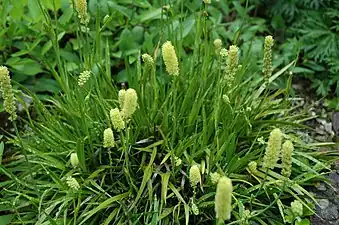| Tofieldia | |
|---|---|
 | |
| Tofieldia pusilla | |
| Scientific classification | |
| Kingdom: | Plantae |
| Clade: | Tracheophytes |
| Clade: | Angiosperms |
| Clade: | Monocots |
| Order: | Alismatales |
| Family: | Tofieldiaceae |
| Genus: | Tofieldia Huds. |
| Type species | |
| Tofieldia palustris [1] Huds. | |
| Synonyms[2] | |
| |
Tofieldia is a small genus of flowering plants described as a genus in 1778.[3][4] It is widespread across much of Europe, Asia, and North America.[2][5][6][7]
Tofieldia was once placed in the lily family, but is now generally included in the newer family Tofieldiaceae. The genus sometimes includes species of genus Triantha. Tofieldia are rhizomatous perennial herbs with spikes or racemes of lily-like flowers.
The name Tofieldia commemorates the British botanist Thomas Tofield.[5]
- Species[2]
- Tofieldia calyculata (L.) Wahlenb. ("German Asphodel") - much of Europe from Spain to Ukraine
- Tofieldia cernua Sm. - Siberia + Russian Far East
- Tofieldia coccinea Richardson - Russia, Mongolia, China, Japan, Korea, Alaska, Canada
- Tofieldia divergens Bureau & Franch. - China (Guizhou, Sichuan, Yunnan)
- Tofieldia furusei (Hiyama) M.N.Tamura & Fuse - Honshu
- Tofieldia glabra Nutt. - North and South Carolina
- Tofieldia himalaica Baker - Nepal, Bhutan, Sikkim, Arunachal Pradesh
- Tofieldia × hybrida A.Kern. ex Asch. & Graebn. - Austrian and Italian Alps
- Tofieldia nuda Maxim. - Honshu, Kyushu
- Tofieldia okuboi Makino - Japan, Kuril Islands
- Tofieldia pusilla (Michx.) Pers. ("Scottish Asphodel") - Subarctic + Subalpine Europe, Asia and North America
- Tofieldia thibetica Franch. - Guizhou, Sichuan, Yunnan
- Tofieldia yoshiiana Makino - Korea, Japan
Use in systems of traditional medicine
At least three species of Tofieldia have been used in traditional medicine:
- T. pusilla was used in Scotland to treat a variety of ailments, including skin conditions, respiratory problems, and digestive issues. The plant's roots have been used to make a tea believed to have a soothing effect on the stomach and intestines.[8]
- T. thibetica is one of the frequently-used ingredients in poly-herbal alcoholic extracts used topically to treat herpes, shingles, wounds, and snake bites. by the Naxi people of the Hengduan Mountains of Northwestern Yunnan.[9]
- T. glabra is a medicinal plant that has been used for centuries in its native North and South Carolina to treat a variety of ailments, being known for its anti-inflammatory, antiseptic, and diuretic properties. Some of the preparations used for these purposes are herbal teas.[10]
Toxicity when raw
The acridity and potential toxicity of Tofieldia spp., when raw, may be accounted for by the fact that the genus, like other basal monocots (including, most notably, the related plant family Araceae [11]) contains calcium oxalate crystals, present, in the case of Tofieldia, arranged in druses and as cuboidal crystals, rather than the raphides more usual in the Araceae.[12] In this connection, it may be noted that the species T. pusilla, when used in Scottish traditional medicine is prepared as a herbal tea [8] and thus subjected to both heat and steeping - both of which are used in the preparation of calcium oxalate-containing plants for food, as a means of eliminating the irritating oxalate crystals - most notably in the case of the popular tropical vegetable taro. [13]
Gallery
 T. calyculata, "German asphodel"
T. calyculata, "German asphodel" T. coccinea flowering in Japan
T. coccinea flowering in Japan_M.N.Tamura_%2526_Fuse%252C_Taxon_60(5)_1346_(2011)_(50150289128).jpg.webp) T. furusei
T. furusei_(50078312512).jpg.webp) T. nuda cv. 'Kurokami'
T. nuda cv. 'Kurokami' T. okuboi flowering in Japan
T. okuboi flowering in Japan
References
- ↑ Le Roy Abrams & Roxana Stinchfield Ferris (1923). Ophioglossaceae to Aristolochiaceae, ferns to birthworts. Illustrated Flora of the Pacific States. Vol. 1. Stanford University Press. p. 372. ISBN 9780804700030.
- 1 2 3 "World Checklist of Selected Plant Families: Royal Botanic Gardens, Kew". apps.kew.org. Retrieved 2017-02-02.
- ↑ Hudson, William. 1778. Flora Anglica, Editio Altera 157("175").
- ↑ "Tropicos | Name - !Tofieldia Huds". www.tropicos.org. Retrieved 2017-02-02.
- 1 2 "Tofieldia in Flora of North America @ efloras.org". www.efloras.org. Retrieved 2017-02-02.
- ↑ "Tofieldia in Flora of China @ efloras.org". www.efloras.org. Retrieved 2017-02-02.
- ↑ Altervista Flora Italiana, genere Tofieldia includes photos and European distribution maps
- 1 2 Wild Flower Web http://www.wildflowerweb.co.uk/plant/2386/scottish-asphodel Retrieved at 11.04 on Monday 8/1/24.
- ↑ Skincare plants of the Naxi of NW Yunnan, China https://www.ncbi.nlm.nih.gov/pmc/articles/PMC8553254/
- ↑ Selina Wamucii https://www.selinawamucii.com/plants/tofieldiaceae/tofieldia-glabra/
- ↑ Watson, John T.; Jones, Roderick C.; Siston, Alicia M.; Diaz, Pamela S.; Gerber, Susan I.; Crowe, John B.; Satzger, R. Duane (2005). "Outbreak of Food-borne Illness Associated with Plant Material Containing Raphides". Clinical Toxicology. 43 (1): 17–21. doi:10.1081/CLT-44721. PMID 15732442. S2CID 388923.
- ↑ Prychid, Christina J., Furness, Carol A. and Rudalli, Paula J. "Systematic Significance of Cell Inclusions in Haemodoraceae and Allied Families: Silica Bodies and Tapetal Raphides" Ann Bot. 2003 Oct; 92(4): 571–580. doi: 10.1093/aob/mcg172 PMCID: PMC4243674PMID: 14507742 https://www.ncbi.nlm.nih.gov/pmc/articles/PMC5320662/ Retrieved at 11.25 on Sunday 7/1/24.
- ↑ The Morton Arboretum Quarterly, Morton Arboretum/University of California, 1965, p. 36.
External links